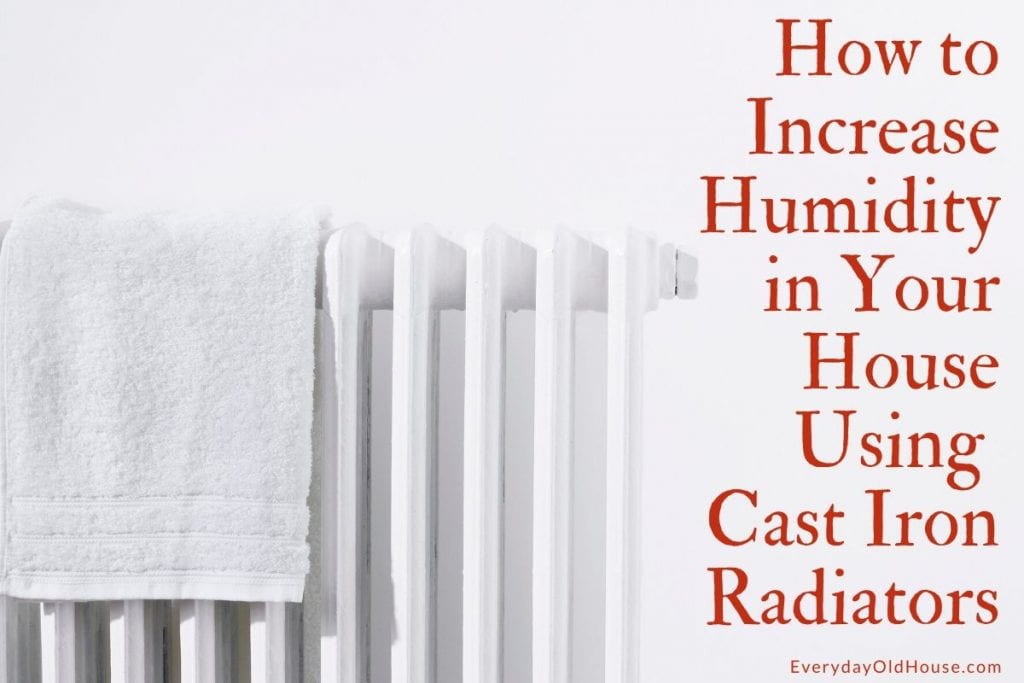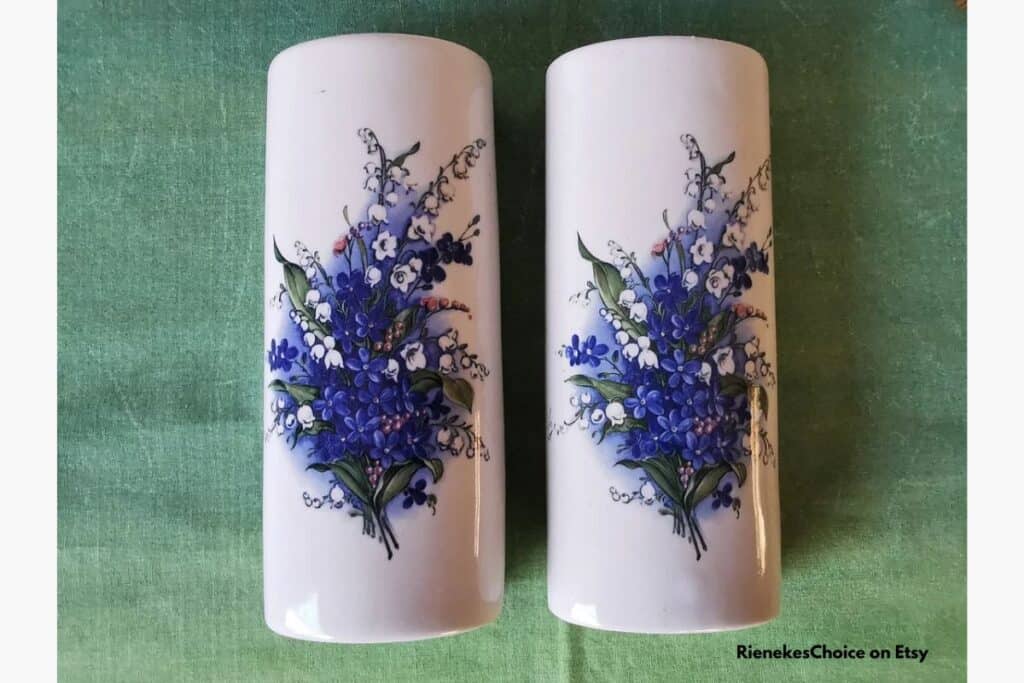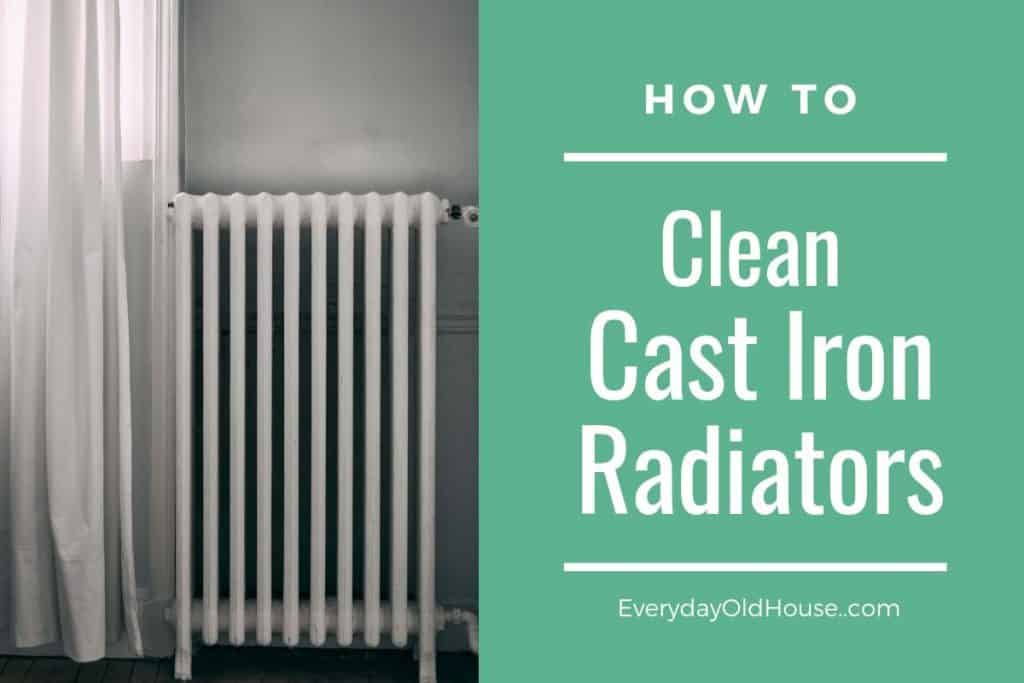Last Updated on March 22, 2024
Winter rewards us with freshly fallen snow, cozy warm fires, and mugs of steaming hot cocoa. But winter also comes with dry air and low humidity in our homes. Luckily, there are simple solutions to increase moisture via cast iron radiator humidifiers.

This post contains affiliate links, including but not limited to, Amazon Associates. As such, I earn from qualifying purchases. Full disclosure located here.
Why Does Humidity Drop in the Winter?
During the winter, humidity levels drop because cold air holds less moisture than the warm summer air.
What can happen in homes exposed to low humidity? According to Apartment Therapy, “low humidity causes static electricity, dry skin and hair, increased susceptibility to colds and respiratory illness”. This leads to an environment where viruses and germs thrive. Plus “wood floors, furniture and millwork will split and crack, paint will chip, and electronics can be damaged because of low humidity levels.”
Yikes!
How to Increase Humidity in Homes
There are several ways to add moisture to your home, including:
- Buying an electric humidifier
- Adding house plants
- Showering with door open
- Filling up tub
- Placing containers of water near radiators
This post addresses the last bullet point – adding moisture by leveraging your cast iron radiators. By either buying (or DIYing) cast iron radiator humidifiers.
Why are Cast Iron Radiator Humidifiers So Great?
First, there is no extra energy needed! Capturing the heat from cast iron radiators and converting it into moisture adds no money to your energy bills. Just the initial expense of buying the humidifier (or supplies to make one).
How great is that?
[Speaking of saving money, consider installing reflector insulation behind your radiators. For less than a $50 investment, we expect to save up to 8% on our utility bills this winter.]
5 Cast Iron Radiator Humidifiers
Cast iron radiator humidifiers work by sitting on top of, or next to, or even underneath your radiator. The water in these humidifiers will evaporate as it’s warmed by the radiator, making your rooms less dry and miserable in the winter.
I’ve divided the 5 options by their location on the radiators: Top, Next and Underneath.
Cast Iron Radiator Humidifiers – Top
These first two cast iron radiator humidifiers sit on top of the radiator to capture the heat to evaporates into the air. These humidifiers commonly have covers with lids or an opening like a kettle where vapor can escape (which makes it easy to refill).
The top of some cast iron radiators are flat, some are not. So before you buy one of these, make sure that the top of your cast iron radiator is flat enough (and big enough) to securely hold a steamer.
1. Lattice Humidifiers
There is a plethora of lattice steamers on the market. Traditionally these are meant for wood stove tops, BUT the smaller ones could potentially be used on top of cast iron radiators. The smaller ones run around 1.5 quarts (traditional black, brilliant blue, and eye-catching red), which should fit on top of a larger cast iron radiator.
Another option is a contemporary take on a classic lattice top steamers specially designed for narrow ledges, perfect for sitting on top of a radiator.
For a fun flare there’s also some with unique tops- from a red chicken to cozy cabin to a dragon that puffs steam out its nostrils! These will definitely help cure the winter blahs!
2. DIY Radiator Humidifier – Top
Another option (and more cost-effective) is to use something around the house as a humidifier. Dig through the kitchen cabinets and use what you already have – a shallow tray or container like these options:
- Ceramic rectangular baking dish in a color that compliments your decor
- Galvanized serving pan or platter. Spruce it up with acrylic paint and a multi-purpose sealer
While I love the frugal idea of DIY steamers, I do foresee two potential problems.
- Not be as heavy as cast iron: These lighter container have a higher risk for accidently falling off the radiator if bumped. A potential fix could be to fill the container with pebbles or pretty multi-colored gems (or even just ones from your backyard).
- No covers: Increased risk of spilling water onto the floor since there are no covers.
Cast Iron Radiator Humidifier – Next To
Instead of sitting a vessel of water on top of the radiator, these next two humidifiers hang off the front of cast iron radiators using hooks. These are usually small in size (you will likely have to buy more than one), come in many shapes and in a variety of materials (ceramic, plastic, and metal).
How do they work? These containers are designed with cures that fit between the radiator rungs or fins. These projections/ indentations maximize the amount of surface area touching the radiator, which results in effective transfer of heat.
But I’ll volunteer that most people had lukewarm reviews of these types of humidifiers. Apparently it is very difficult to find a side humidifier that matches the exact dimensions and curves of cast iron radiators to product a snug fit.
3. Kilian Hardware Radiator Humidifier
An option to the SIDE humidifier is a humidifier that slides THROUGH the radiator. Kilian Hardware Company located in Philadelphia offers a “old-fashioned” metal humidifier. This vintage style humidifier has a thin metal arm that slides inside the cast iron radiator and rests on the horizontal interior struts. There is a triangular reservoir that sticks out the radiator for filling.

These cast iron radiator humidifiers are 19″ long by 4-1/2″ tall, with a 1/2″ insert width. The edge of this reservoir are sharp, so Kilian recommends blunting them with electrical tape (buy silver tape to match the metal). Reviews note that Kilian sometimes has problems with their supplier, so call ahead (215-247-0945) to ensure in stock.
My Review
Last year I bought Kilian’s humidifier for our bedroom. Overall, it works well and I’d recommend (and no, I don’t get any commission if you buy one….).
It did take a little push-pull on the thin metal arm to achieve a snug fit inside the radiator. I like that it’s metal versus plastic (i.e. better heat conductor).
It did a great job of passively adding moisture to the air. I don’t think it completely solves our moisture problem. Admittedly in the thick of winter we still turn on our humidifier when we sleep. BUT I like that this runs 24/7 passively. For the price it seems like a value.
4. Vintage Radiator Humidifier
Another option is the old fashioned way
Snow Joe
Snow Joe’s Old-Fashioned Radiator Humidifier for Steam Heat humidifier that hangs off on the front of the radiator. Available in black or beige.
It’s the modern, plastic version of the metal vintage ones popular in the olden days. Below is a photo of the vintage metal ones in home catalogs from the 1930s and 1940s.
Admittedly, the reviews on these cast iron radiator humidifiers aren’t spectacular on Amazon. But for the cost, you might find it worth trying.
Vintage Ceramic
Another humidifier option that hangs off the side of the cast iron radiator are ceramic radiator humidifiers. These ceramic cuties add some personality to your cast iron radiators.
Personally, I think these look MUCH better than the above Snow Joe. But these aren’t as easy to find as the Snow Joe. The best bet for finding these vintage radiator humidifiers is searching for “ceramic humidifer for radiator” on Etsy.

Note
You will find the majority are these are from sellers in Europe. If you live the United State like myself, use the filter to limit results to US only.
But don’t expect a huge number of results. When I did a search I found ceramic humidifiers only at these two antique shop – SassySoSweetBoutique and Annickantiques.
5. DIY Radiator Humidifier – BOTTOM
The last place to increase humidity using cast iron radiators is to place it underneath the radiators. But beware of this option if you have pets! Dogs and cats might use it for a water bowl. (Or maybe your pet is just smarter than mine…)
Unlike humidifiers placed on top of along the sides of the radiator, this option is less visible, so personally I don’t think it needs to be too fancy. I would use a shallow basic aluminum baking sheet like the ones below. The pans should be less than 9″ wide and 2″ tall so they should fit under most traditional cast iron radiators.
Things to Consider….
Before you buy (or DIY) a cast iron radiator humidifier to add moisture to your home, don’t forget to first think through these 5 considerations:
1. Pets or Children
If you have pets or children, consider the challenges posed with some of these humidifiers.
Your dog might view a pan placed under the radiator as a water bowl.
Or a cat that likes to climb the radiator a ceramic pot placed on top of your cast iron radiator will quickly end up on your floor broken in pieces.
Or in my case, curious toddlers who touch (and break) everything….
2. Radiator Size and Shape
Radiators come in different sizes and shapes. Some have flat tops that would hold a lattice humidifier perfectly, while other radiators are too curvy. Make sure to measure your radiator first before buying to ensure it will fit!
3. Number of Humidifiers
For maximum efficiency, consider using more than one humidifier per radiator. Place a cast iron lattice steamer on top and an aluminum baking pan underneath the same radiator.
4. Ambiance
As a bonus, add a few drops of an essential oil such as eucalyptus, lavender, and peppermint to the water in the humidifier for aromatherapy.
5. Price
These options can cost anywhere from $10-$150, so check your budget to see what makes you comfortable.
If you want an even simpler, completely free way to create a DIY humidifier to introduce moisture into the air? Leave wet towels and clothes out to dry near the radiators. Can’t get any low-tech (or cheaper) than that!















I remember having cast iron radiators in the school I went to in junior high. Those wood stove steamers would be great for putting more moisture in the air.
I need more humidity in my house and wish I had a cast iron radiator now! Thanks for sharing on my blog, TheThriftyHome.com